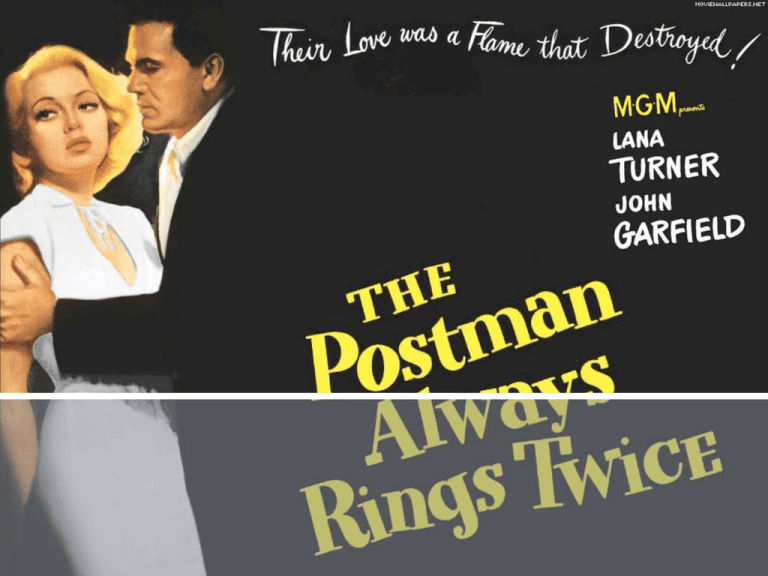
PLOT OVERVIEW:
A married woman (Cora Smith)
and a drifter name Frank
Chambers fall in love, then plot
to murder her husband (Nick
Smith). The first murder
attempt backfires and Frank
leaves town. He can’t stay
away however and is drawn
back to Cora’s side. They plan a
second murder which is
successful. They get Nick
drunk then drive him and his
vehicle off a cliff. Once the
deed is done, they must live
with the consequences of their
actions.
Expressionist Camerawork/Lighting:
Lighting: high contrast –
expressionistic - lighting: deep
ominous shadows and sharp
‘highlights’ – particularly in the
hospital scene where Frank is in
bed, the venetian blinds cast
fragmented shadows on the wall
which appear almost like prison
bars. This also appears in the
court scene where Frank and Cora
discuss their situation. This is a
visual metaphor for their guilt and
feeling of entrapment. It
foreshadows their eventual
death/physical imprisonment.
Antihero :
Frank Chambers. Like Walter,
Frank may seem the victim of
Cora’s conniving plan to murder
Nick and avoid being sent off as
nurse to his paraplegic sister in
Canada. However, he is equally
culpable – he did it in order to
Behind his charm and mild
manners he is a ruthless criminal
(adultery, murder larceny)
“Stealing a man's wife, that's
nothing, but stealing a man's
car, that's larceny”
Femme Fatale:
•
Cora Smith – single-minded and self-motivated,
seductive, duplicitous.
•
Married Nick for his money
•
Uses her sexual appeal to convince Frank to kill
Nick so that they can be together. In reality it is
largely to prevent being sent away to care for
Nick’s paraplegic sister in Canada
•
Cora Smith: I want to make something of this
place, I want to make it into an honest-togoodness...
Frank Chambers: Well, aren't we ambitious.
•
"There's, there's one thing we could do that
would fix everything for us." -- Turner, first
bringing up murder as a solution to her and
Garfield's problems.
"But they'd hang you for a thing like that."
"Oh, not if we did it right, and you're smart,
Frank. You'll think of a way. Plenty of men have."
Narrative:
Frank and Cora’s on and off ‘romance’ and
plans twist and turn: they despise each
other but are irresistibly attracted to one
another – this seals their fate.
First Person Subjective Voiceover:
Frank’s voice-over is
revealed to be a death
row confessional to a
priest – he
understands he must
pay with his life for the
sins he has commit.
Theme:
The idea of paranoia and distrust is shown when
Frank is duped to believe that Cora is trying to
blame him completely for Nick’s death.
Fate is portrayed in the end of the film. Frank
accepts that he must accept the punishment he
has brought upon himself through his criminal
activities. Even though he is innocent of Cora’s
death, he is responsible for Nick’s – he is guilty
and can’t escape this fate.
Industry Influences on Film Noir
Cheap film productions made by ‘Poverty
Row’ studios and some ‘Big 5 studios’ –
originally made as the ‘cheap’ film in the
Depression-era ‘double feature.
Contribution to meaning:
Minimal funding and resourcing of
many Films Noir forced directors to be
innovative and clever in their
cinematography and lighting to
maximise each shot.
Relationship to Society:
War-time shortages reduced resources
available to film-makers – this helped drive
the innovation and expressionist filmmaking seen in Noir.
Noir began as a B-grade genre – its
popularity is evidenced in the fact that it
quickly became an ‘A-grade’ genre adopted
by the big studios. (plenty of B-grade noirs
were still made)
EVIDENCE:
Detour is a B-grade Noir masterpiece – innovative
storytelling and cinematography. E.g triangular
composition in diner scene.
The Hay’s Production Code
Film has long been regarded as a potent and influential force in society.
The Hays Code was a set of production directives, voluntarily adopted by all the
major studios designed to pre-empt a government-run censorship program.
The Hays Code (the informal name for The Motion Picture Production Code) was
adopted in 1930 but not seriously enforced until 1934. It was a set of rules which
governed the American filmmaking industry and that shaped American cinema for
over three decades. The cod evolved after a wave of complaints and rulings about
the content of movies in the early 20th century, as well as a number of perceived
immoral people within the industry itself (most infamously, Fatty Arbuckle).
The Postman Always Rings Twice vs Hay’s Code
Natural blonde Audrey Totter (who was of Austrian and Swedish descent) had to
darken her hair for her small role in the film to avoid any confusion with leading lady
Lana Turner.
To offset any bad publicity over the sexual nature of her role, MGM's publicity
department arranged to have Turner photographed on the set with her two-year-old
daughter Cheryl Crane and even had her take the child to the picture's New York City
premiere.
Despite winning the approval of the Production Code Administration, The Postman
Always Rings Twice was banned in Indonesia, Switzerland and Spain.
"It was a real chore to do Postman under the Hays Office, but I think I managed to
get the sex across."
- Tay Garnett
Contribution to Meaning:
Restricted the portrayal of adultery and crime
(particularly murder) on screen.
Noir often pushed the boundaries of the Hays
Code – but also relied a lot on innuendo rather
than blatant portrayal.
Sin, in any form, is punished at the end of Noir.
Relationship to Society:
As a potent force in society, film were to
uphold good morals, and any character
who broke with good morals was to be
punished.
EVIDENCE:
The Postman Always Rings Twice
Frank ends up on death-row: unable to escape the
death penalty – but repenting and accepting o f
the need to pay for his sins.
Detour
Vera’s murder is not seen on screen.
Ending changed – Al is caught by police: not left
to wander free.










